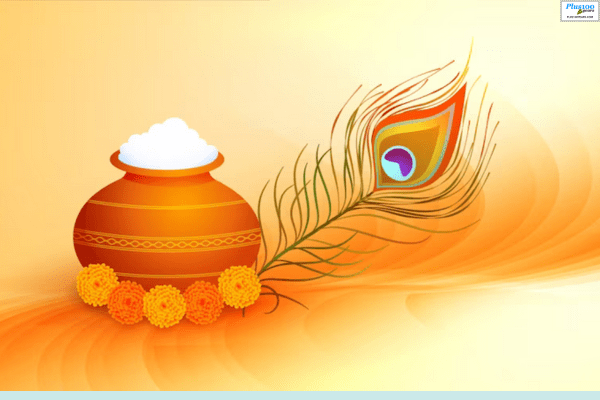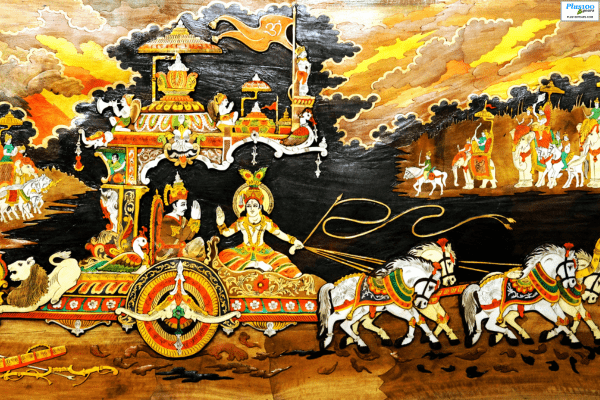
The Mahabharata is a Hindu epic that tells the story of the Kurukshetra War and the fates of the Kaurava and Pandava princes. It is one of the longest poems ever written, with over 200,000 lines of verse.
This epic has been passed down orally for centuries and has become a cornerstone of Hindu culture. Here are 50 interesting facts about the Mahabharata that will help you appreciate this classic tale even more.

- The Mahabharata is the longest epic poem in the world, consisting of over 200,000 lines of verse.
- The story of the Mahabharata is set in ancient India, during the period of the Kuru dynasty.
- The Mahabharata is divided into 18 books, each of which is called a Parva.
- The first book of the Mahabharata is called the Adi Parva, which means the "book of beginnings."
- The Mahabharata is attributed to the sage Vyasa, who is said to have dictated the poem to the god Ganesha.
- It is believed Mahabharata have been composed between the duration of 400 BCE and 400 CE.
- The Mahabharata is written in Sanskrit, which was the language of ancient India.
- The Mahabharata is considered one of the two major Sanskrit epics of ancient India. The other one is the Ramayana.

- The Mahabharata is not only a literary masterpiece, but it is also a philosophical treatise, a religious text, and a cultural artifact.
- The Mahabharata contains many different genres of literature, including poetry, prose, and drama.
- The Mahabharata is said to contain over 500 stories within the main narrative.
- The central theme of the Mahabharata is the struggle between good and evil and the ultimate triumph of good over evil.
- The Mahabharata is a multi-layered narrative that weaves together stories of love, war, politics, philosophy, and religion.
- The Mahabharata contains some of the most beloved characters in Hindu mythology, including Arjuna, Krishna, Draupadi, and Bhishma.
- The Mahabharata is also known for its intricate plot, which is full of twists, turns, and surprises.
- The Mahabharata is a complex work that requires a great deal of background knowledge to understand fully.
- The Mahabharata has been translated into many languages, including English, French, German, and Spanish.
- The Mahabharata has inspired countless works of art, including paintings, sculptures, and films.
- The Mahabharata is not just a work of fiction but is also seen as a sacred text by many Hindus.
- The Mahabharata is said to contain all the knowledge and wisdom of the ancient sages.
- The Mahabharata has been used as a source of guidance and inspiration by millions of people throughout the centuries.
- The Mahabharata is believed to have been transmitted orally for centuries before it was finally written down.
- The Mahabharata is said to have been recited by the sage Vyasa to his disciple, Vaishampayana.
- The Mahabharata was first written down in the Gupta period (320-550 CE).
More Interesting Facts About Mabharatha
- The Mahabharata was originally written on palm leaves, which were tied together to form a book.
- The Mahabharata is said to contain over 100,000 characters, making it one of the most populous works of fiction ever written.
- The Mahabharata contains many important themes, such as duty, morality, honor, and karma.

- The Mahabharata is also known for its portrayal of women, with many strong female characters, such as Draupadi and Kunti.
- The Mahabharata is a source of inspiration for many Indians, as it contains lessons on how to live a virtuous life.
- The Mahabharata is also a source of controversy, as it contains elements of violence, greed, and political intrigue.
- The Mahabharata has been the subject of many scholarly studies, with academics analyzing its themes, structure, and historical context.
- The Mahabharata has been adapted into numerous plays, films, and television shows, both in India and abroad.
- The Mahabharata is a cornerstone of Hindu culture, with many religious rituals and festivals based on its teachings.
- The Mahabharata is also important in Buddhist and Jain traditions, as it contains teachings that are relevant to these religions as well.
- The Mahabharata contains many references to other Hindu texts, such as the Vedas and the Upanishads.
- The Mahabharata is also known for its use of symbolism, with many characters and events representing deeper philosophical concepts.
- The Mahabharata contains many memorable quotes, such as Krishna's advice to Arjuna in the Bhagavad Gita.
- The Mahabharata has been the subject of many adaptations and retellings, with each version adding its own interpretation and perspective to the story.
- The Mahabharata is not just a work of literature, but also a source of spiritual guidance and inspiration for many Hindus.
- The Mahabharata is seen as a reflection of the human condition, with its portrayal of love, hate, jealousy, and redemption.
- The Mahabharata is also a testament to the power of storytelling, as it has captivated audiences for centuries.
- The Mahabharata is often compared to the Iliad and the Odyssey, as it shares many similarities with these classic epics.
- The Mahabharata has been the subject of many academic debates and controversies, with scholars disagreeing on its historical accuracy and interpretation.
- The Mahabharata is a reminder of the rich cultural heritage of India, with its complex mythology, diverse traditions, and timeless wisdom.
- The Mahabharata has influenced many aspects of Indian culture, from art and literature to religion and politics.
- The Mahabharata has been translated into many languages, with each translation adding its own interpretation and perspective to the story.
- The Mahabharata has been a source of inspiration for many Indian writers, with its timeless themes and unforgettable characters.
- The Mahabharata is a testament to the enduring power of storytelling, as it continues to captivate audiences around the world.
- The Mahabharata is not just a literary masterpiece, but also a cultural treasure that has shaped the identity of India and its people for centuries.
Interesting Facts About Mahabharata & Characteristics Of Mahabharata
- Arjuna was the only one who had the privilege of seeing Lord Krishna's Vishwaroopa or the universal form.
- Bhima, the second of the Pandava brothers, was said to have killed Jarasandha, the ruler of Magadha, by splitting him into two halves.
- Draupadi, the wife of the Pandava brothers, was born from the yajna (fire sacrifice) conducted by King Drupada to avenge his humiliation by Drona.
- Karna, the son of Kunti and the sun god Surya was raised by a charioteer named Adhiratha and his wife Radha.
- Duryodhana, the eldest of the Kaurava brothers, was said to have been born with a steel-like body, impervious to weapons.
- Shakuni, the maternal uncle of Duryodhana, was a master of the game of dice and was said to have played a key role in instigating the Kurukshetra war.
- Shikhandi, the son of King Drupada, was born a girl but was later transformed into a man by Lord Shiva's boon to help Bhishma's death.
- Yudhishthira, the eldest of the Pandava brothers, was known for his adherence to dharma and was said to have never uttered a lie.
- Abhimanyu, the son of Arjuna and Subhadra, was said to have known how to penetrate the Chakravyuha, a battle formation, but not how to get out of it.
- Gandhari, the mother of the Kaurava brothers, had a hundred sons, the eldest being Duryodhana.
- Dhritarashtra, the father of the Kaurava brothers, was born blind and was said to have ruled the kingdom of Hastinapur through his younger brother Pandu.
- Kunti, the mother of the Pandava brothers, was said to have had a boon from Sage Durvasa that allowed her to summon any god and have a child with them.
- Vidura, the half-brother of Dhritarashtra and Pandu, was known for his wisdom and righteousness and was said to have been born from a union between Sage Vyasa and a serving maid.
- Bhishma, the granduncle of both the Pandavas and Kauravas, had taken a vow of celibacy, which prevented him from becoming the king of Hastinapur.
- Krishna, an avatar of Lord Vishnu, was a close friend and advisor to Arjuna and played a key role in the events leading up to the Kurukshetra war.
- Kripacharya, a teacher and advisor to both the Pandavas and Kauravas, was said to have been born from a drop of blood shed by King Shantanu while hunting.

- Dronacharya, a teacher and advisor to the Kauravas, was a master of military arts and was said to have taught archery to both Arjuna and Karna.
- Ashwatthama, the son of Dronacharya, was said to have been born with a gem on his forehead, which granted him protection from all kinds of harm.
- Ekalavya, a talented archer, was refused by Dronacharya to teach him archery, as he belonged to a lower caste, but he still managed to become a skilled archer.
- Jarasandha, the ruler of Magadha, was said to have been killed by Bhima by splitting him into two.
- Ghatotkacha, the son of Bhima and Hidimbi, had the ability to become a giant and was a key warrior in the Pandava army during the Kurukshetra war.
- Satyavati, the mother of Vyasa and the grandmother of both Pandu and Dhritarashtra was a fisherman's daughter who was later married to King Shantanu.
Mahabharata is an ancient epic and one of the important of Mahabharata is Dharma. Many facts about Mahabharata explained dharma.
- Kichaka, the brother-in-law of the king of Virata, was killed by Bhima in disguise after he tried to molest Draupadi.
- Amba, the princess of Kashi, was rejected by Bhishma as a bride, which led her to seek revenge and eventually be reborn as Shikhandi.
- Ulupi, a naga princess, fell in love with Arjuna and helped him during the Kurukshetra war.
- Veda Vyasa, the author of the Mahabharata, was the son of Satyavati and the sage Parashara.
- Chitrangada, the son of Santanu and the first king of Manipur was killed by a Gandharva during a battle.
- Kauravas, the hundred sons of Dhritarashtra and Gandhari, were all killed in the Kurukshetra war except for Yuyutsu, who switched sides to fight for the Pandavas.

- Dhrishtadyumna, the son of Drupada and the commander-in-chief of the Pandava army was responsible for killing Dronacharya during the war.
- Sanjaya, the advisor, and charioteer of Dhritarashtra had the gift of clairvoyance and was able to narrate the events of the war to the blind king.
War Strategies (Vyuhas) in Mahabharata
1. Chakra Vyuha
2. Gauda Vyuha
3. Makara Vyuha
4. Krauncha Vyuha
5. Sudarshana Chakra Vyuha
6. Ghorpadha
Not only these but many other vyuhas are there in Mahabharata
In conclusion, the Mahabharata is a rich and complex epic that continues to captivate audiences around the world.
With its timeless themes, unforgettable characters, and vivid storytelling, the Mahabharata has left an indelible mark on Indian culture and society.
As we have seen, the Mahabharata contains many interesting facts and details, from its length and structure to its portrayal of women and use of symbolism.
It is a work that has inspired countless adaptations, retellings, and scholarly studies, and it continues to be a source of spiritual guidance and inspiration for many Hindus.
Moreover, the Mahabharata is a testament to the power of storytelling, as it has managed to survive for thousands of years and remain relevant to contemporary audiences.
Its themes of love, hate, jealousy, and redemption are universal, and its lessons on duty, morality, and karma continue to resonate with people of all backgrounds and beliefs.
Overall, the Mahabharata is a cultural treasure that has shaped the identity of India and its people, and it will undoubtedly continue to be a source of fascination and inspiration for generations to come. Thanks for reading interesting facts about Mahabharata
Add new comment